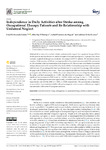Mostrar o rexistro simple do ítem
Independence in daily activities after stroke among occupational therapy patients and Its relationship with unilateral neglect
| dc.contributor.author | De-Rosende, Iván | |
| dc.contributor.author | Rey-Villamayor, Alba | |
| dc.contributor.author | Francisco-de-Miguel, Isabel | |
| dc.contributor.author | Ávila Álvarez, Adriana I. | |
| dc.date.accessioned | 2022-06-28T09:33:16Z | |
| dc.date.available | 2022-06-28T09:33:16Z | |
| dc.date.issued | 2021-07-15 | |
| dc.identifier.citation | De-Rosende-Celeiro, I.; Rey-Villamayor, A.; Francisco-de-Miguel, I.; Ávila-Álvarez, A. Independence in Daily Activities after Stroke among Occupational Therapy Patients and Its Relationship with Unilateral Neglect. Int. J. Environ. Res. Public Health 2021, 18, 7537. https:// doi.org/10.3390/ijerph18147537 | es_ES |
| dc.identifier.issn | 1660-4601 | |
| dc.identifier.uri | http://hdl.handle.net/2183/31013 | |
| dc.description.abstract | [Abstract] More research is needed to better understand the impact of occupational therapy (OT) in stroke patients and syndromes of unilateral neglect (UN) and anosognosia. A prospective, observational, longitudinal design was conducted on a sample of 27 OT patients. The objectives were to examine: (1) the presence of UN and anosognosia; (2) the functional outcomes; and (3) the association of UN at baseline with functional status at discharge from OT. The outcomes were Barthel (functional independence) and the Rivermead Mobility Index (RMI). The baseline proportion of participants with UN was 33% according to the Star Cancellation Test (STC), and 48.1% according to the Catherine Bergego Scale (CBS) therapist-version. There was a significant difference between the therapist and participant-rated CBS scores (p = 0.004). Functional independence improved significantly between the initial and final assessments (p < 0.001); the effect size (r) was large (r = 0.61). There was a significant improvement in RMI scores (p < 0.001), which was large in size (r = 0.59). Both the STC and CBS-therapist scores were significantly correlated with the Barthel (p < 0.001, p = 0.005, respectively) and with the RMI (p = 0.004, p = 0.028, respectively). The participants substantially enhanced their functional status skills. UN and anosognosia were common problems, and neglect was associated with worse OT program outcomes. | es_ES |
| dc.language.iso | eng | es_ES |
| dc.publisher | MDPI | es_ES |
| dc.relation.uri | https://doi.org/10.3390/ijerph18147537 | es_ES |
| dc.rights | Atribución 3.0 España | es_ES |
| dc.rights.uri | http://creativecommons.org/licenses/by/3.0/es/ | * |
| dc.subject | Activities of daily living | es_ES |
| dc.subject | Anosognosia | es_ES |
| dc.subject | Occupational therapy | es_ES |
| dc.subject | Stroke | es_ES |
| dc.subject | Unilateral neglect | es_ES |
| dc.title | Independence in daily activities after stroke among occupational therapy patients and Its relationship with unilateral neglect | es_ES |
| dc.type | info:eu-repo/semantics/article | es_ES |
| dc.rights.access | info:eu-repo/semantics/openAccess | es_ES |
| UDC.journalTitle | International Journal of Environmental Research and Public Health | es_ES |
| UDC.volume | 18 | es_ES |
| UDC.issue | 14 | es_ES |
| UDC.startPage | 7537 | es_ES |
Ficheiros no ítem
Este ítem aparece na(s) seguinte(s) colección(s)
-
UI-TOINF - Artigos [17]






